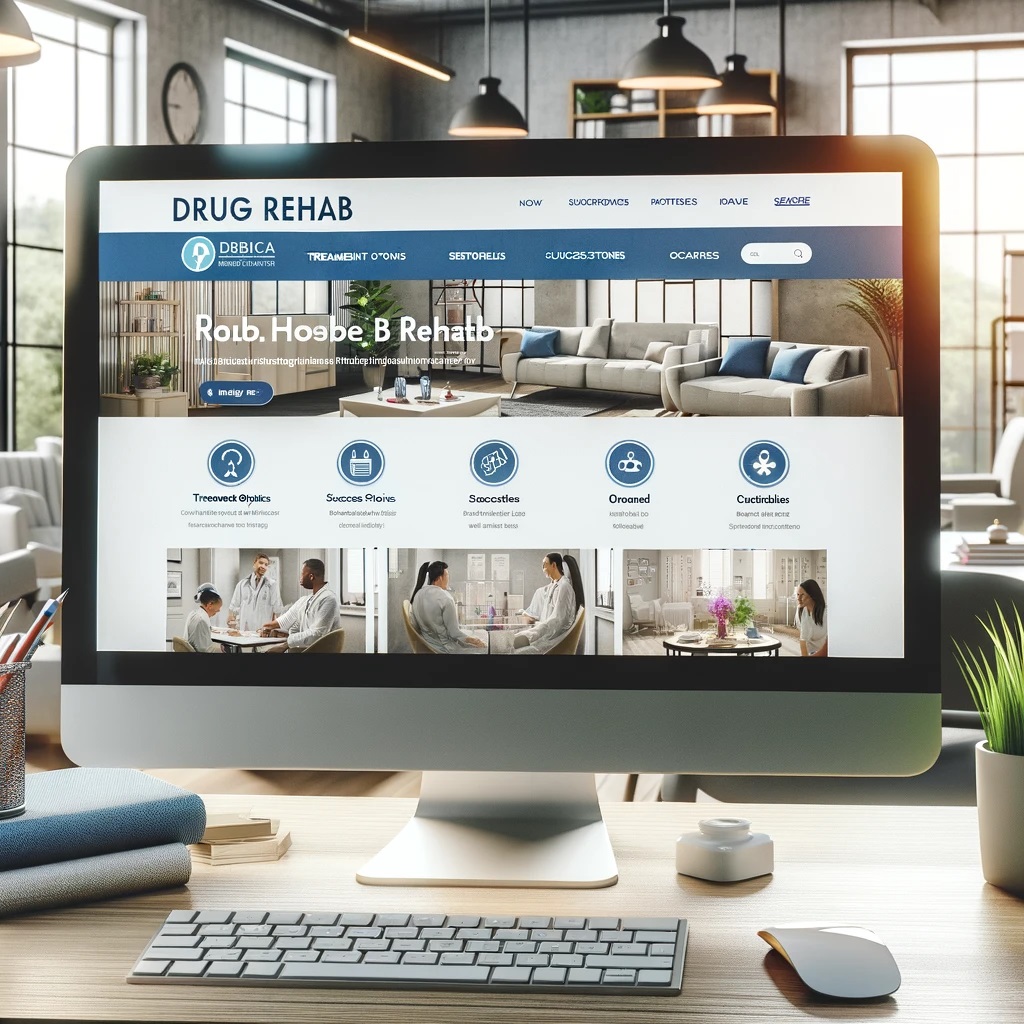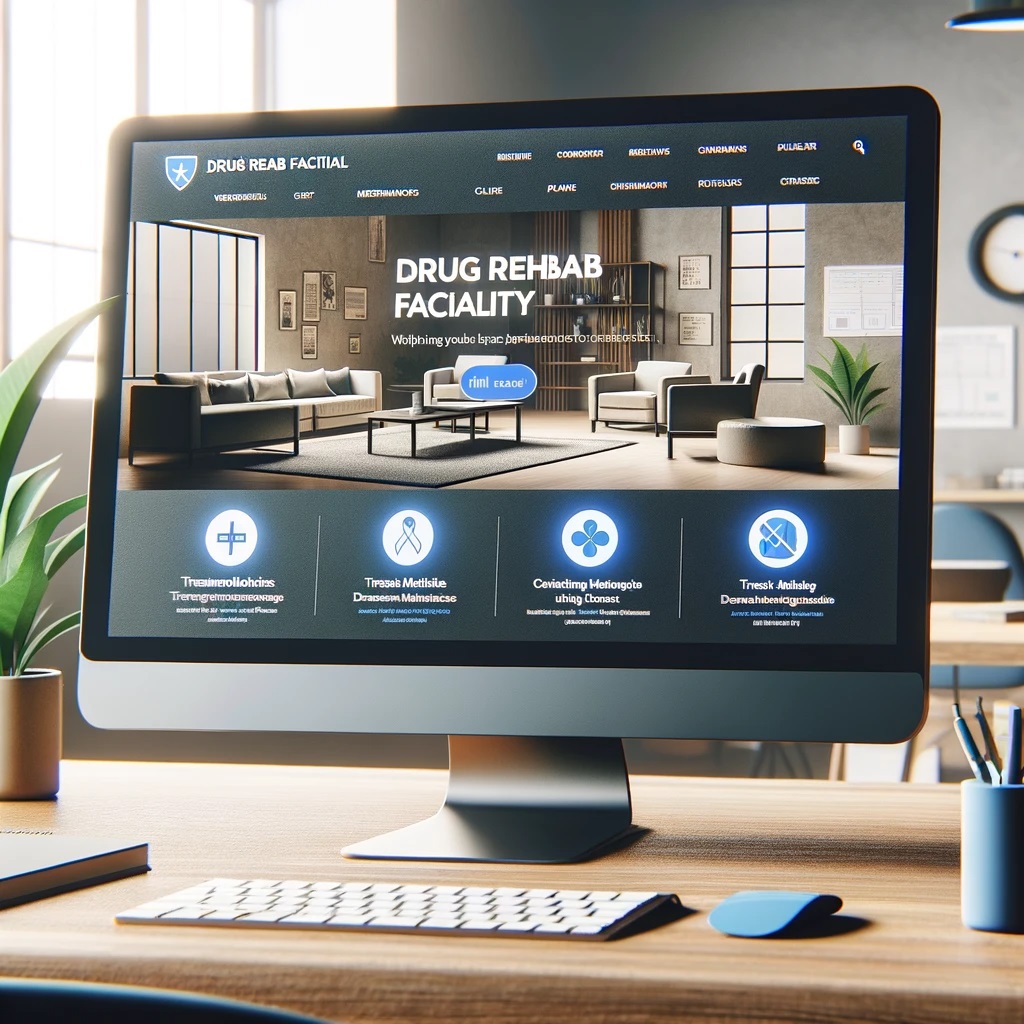Table of Contents
Drug Rehab Website Optimization
Introduction: The Critical Role of Online Presence in Drug Rehab Services
In today’s digitally-driven world, establishing a strong online presence is paramount for any industry, especially for drug rehabilitation centers. Recognizing the power of digital platforms is crucial in reaching out to those in need of your services. This chapter delves into why an enhanced online presence is vital and how optimizing your drug rehab website plays a significant role in your facility’s commercial success.
Understanding the Importance of Online Presence in Drug Rehab Services
- Digital Visibility as a Gateway to Client Engagement: In the realm of healthcare and rehabilitation, the first interaction between a potential client and a service provider often begins online. A robust online presence for your drug rehab center ensures that when individuals seek help, your facility appears as a reliable and accessible option. This visibility is not just about being seen; it’s about being seen by the right people at the right time.
- Building Trust through Online Channels: Trust is a cornerstone in the healthcare sector, more so in the sensitive area of drug rehabilitation. A strong online presence, supported by professional, empathetic, and informative content, establishes your facility as a trustworthy source. It’s about creating a digital environment where potential clients feel understood and supported even before they make the first call.
- Competitive Edge in a Crowded Digital Landscape: The internet is a crowded place, with numerous facilities vying for attention. A well-optimized website, enriched with relevant and engaging content, sets your center apart. It’s not just about attracting more traffic; it’s about attracting the right traffic – individuals genuinely seeking help for themselves or their loved ones.
Overview of Drug Rehab Website Optimization and Its Commercial Significance
- Optimization for Enhanced User Experience: At its core, website optimization for your drug rehab center is about ensuring a seamless user experience. From easy navigation to fast loading times and mobile responsiveness, every aspect of your website should guide potential clients smoothly through their journey of seeking help.
- Content Optimization for Relevance and Reach: The content on your drug rehab website must resonate with your audience. Utilizing SEO strategies to include relevant keywords, addressing common concerns about drug rehabilitation, and providing clear, helpful information positions your website as a valuable resource. It’s not just about ranking high in search engines; it’s about being the answer to someone’s search for help.
- The Commercial Impact of SEO: Investing in SEO for your drug rehab website is not just a marketing tactic; it’s a business strategy. By increasing your online visibility, you’re directly influencing your facility’s ability to attract and help more clients. This, in turn, drives revenue and supports the growth and sustainability of your services.

Start optimizing your website today to improve accessibility and engagement in your journey towards digital transformation.
Start your growth today!Defining the Landscape
Exploring the Concept of Drug Rehab Website Optimization
In the digital age, the first impression of any healthcare facility, including drug rehab centers, is often formed online. For C-level executives managing these facilities, understanding the concept of website optimization is crucial. This isn’t just about a digital facelift; it’s a strategic approach to making your center visible, accessible, and relevant in the online space.
- Website Optimization: Beyond Aesthetics: Drug rehab website optimization encompasses various elements – from the visual appeal and user experience to the technical performance of the site. Every aspect should work harmoniously to not only attract visitors but also provide them with valuable information and a seamless user journey.
- Content as a Pillar of Optimization: The heart of any website is its content. For drug rehab centers, this means providing accurate, compassionate, and helpful information. Content should be structured and written in a way that resonates with individuals seeking help, employing empathetic language, clear information on services, and supportive resources.
- User Experience and Accessibility: An optimized website is easily navigable, loads quickly, and is accessible across various devices, especially mobile phones. The aim is to reduce barriers to information and services, making it as simple as possible for visitors to find the help they need.
- Search Engine Optimization (SEO): SEO strategies are applied to increase the visibility of your website on search engine results pages. This involves using relevant keywords, optimizing meta tags and descriptions, and ensuring your website’s content aligns with what potential clients are searching for.
The Role of SEO in Strengthening Online Visibility for Drug Rehab Centers
For drug rehab centers, SEO isn’t just a marketing tool; it’s a vital component of your service to the community. By improving your online visibility, you’re not just reaching more potential clients, but you’re also providing a crucial touchpoint for individuals in need.
- Keywords: Connecting Needs with Services: Integrating the right keywords into your website’s content helps in matching your services with the search queries of those seeking rehab services. This involves a careful selection of terms that potential clients are likely to use when searching for drug rehab services.
- Local SEO: Reaching the Community: Many individuals looking for rehab services start their search locally. Implementing local SEO practices, like optimizing for location-based keywords and managing local business listings, can significantly increase your center’s visibility in local search results.
- Building Authority and Trust through SEO: High rankings in search engine results not only increase visibility but also lend credibility to your facility. By providing valuable, high-quality content and securing backlinks from reputable sources, your center can establish itself as an authoritative voice in the field of drug rehabilitation.
- Continuous Optimization: SEO is not a one-time task but a continuous process. It involves regularly updating your website, adding fresh content, and staying abreast of the latest SEO trends and algorithm changes.

Begin by evaluating your website and optimizing it to better serve and support those battling addiction.
Let’s work together!SEO Techniques for Drug Rehab Websites
Understanding and implementing effective SEO techniques is key to enhancing your online presence. This section details actionable strategies to optimize your website, ensuring it not only ranks high in search engine results but also genuinely resonates with those in need of your services.
Keyword Research: Identifying Relevant Terms for Drug Rehab Services
- Understanding User Intent: Begin by comprehending the intent behind search queries related to drug rehabilitation. This involves identifying keywords that potential clients might use when seeking rehab services. Tools like Google Keyword Planner or ahrefs offer insights into popular and relevant search terms.
- Long-Tail Keywords: Incorporate long-tail keywords that are specific to the drug rehab industry. These are more targeted than generic terms and often have a higher conversion rate as they align closely with the searcher’s intent.
- Competitor Analysis: Analyze keywords used by competing rehab centers. This gives an understanding of the industry standard and helps in identifying any gaps your website can fill.
On-Page Optimization: Content Quality and Relevance
- Content as a Communication Tool: Your website’s content should serve as a bridge connecting your facility to those seeking help. Ensure it is informative, empathetic, and answers common questions about drug rehabilitation.
- Keyword Integration: Keywords should naturally blend into your content. Avoid overstuffing; instead, focus on creating meaningful content that seamlessly incorporates relevant keywords.
Technical SEO: Ensuring Website Performance and Accessibility
- Site Speed Optimization: A fast-loading website is crucial for a positive user experience. Use tools like Google PageSpeed Insights to identify and fix any issues that may be slowing down your site.
- Mobile Responsiveness: With the increasing use of mobile devices, ensure your website is mobile-friendly. This not only improves user experience but is also a ranking factor for search engines.
Off-Page Optimization: Building Credibility and Authority
- High-Quality Backlinks: Acquiring backlinks from reputable sources within the healthcare and rehab industry can significantly boost your site’s authority and search engine rankings.
- Social Media Engagement: Actively engage on social media platforms to increase brand visibility. Regularly sharing valuable content and interacting with your audience can drive traffic back to your website.

Start applying these SEO techniques to boost your website’s visibility and become a beacon of hope for those in need.
Contact us now!Local SEO Strategies for Drug Rehab Centers
For drug rehab facilities, local SEO is a critical component of an effective digital marketing strategy. This section addresses the importance of local SEO and provides actionable tactics for C-level executives to enhance their facility’s local online presence, ensuring they reach the individuals who need their services most.
Importance of Local SEO in Attracting Nearby Clients
- Targeting the Local Community: Local SEO helps in reaching out to individuals within your facility’s vicinity. Many seeking rehab services prefer facilities close to home, and local SEO ensures your center appears prominently in their search results.
- Increased Visibility in Local Searches: Optimizing for local SEO increases the likelihood of your facility appearing in ‘near me’ search queries, a common way people search for services in their area.
- Competitive Advantage: By focusing on local SEO, your facility can gain a competitive edge in the local market, standing out among other rehab centers.
Optimizing for Local Search: Google My Business and Local Citations
- Google My Business (GMB) Optimization: Set up and regularly update your GMB listing. This includes accurate business details, working hours, and location information. GMB listings significantly influence local search rankings and visibility.
- Consistent Local Citations: Ensure your facility’s information is consistent across various online directories. Consistency in name, address, and phone number (NAP) across all platforms is crucial for local SEO.
- Local Keywords: Incorporate local keywords into your website’s content. This includes specific references to your city, region, or neighborhood, aligning your site with local search queries.
Encouraging Reviews and Ratings for Local Trust Building
- Cultivating Positive Reviews: Encourage satisfied clients and their families to leave positive reviews on your GMB listing and other review sites. This not only improves local SEO but also builds trust and credibility.
- Responding to Reviews: Actively respond to both positive and negative reviews. This demonstrates your facility’s commitment to client satisfaction and engagement.
- Leveraging Testimonials on Your Website: Feature positive testimonials on your website to enhance trust and credibility with potential clients.

Assess and improve your local SEO strategies to become a trusted resource for those seeking rehabilitation services.
Get in touch with us!Content Marketing for Drug Rehab Websites
Content marketing plays an essential role in enhancing the online presence of drug rehab facilities. It involves creating and distributing valuable, relevant, and consistent content to attract and engage a clearly defined audience.
Developing a Content Strategy to Address User Needs
- Identifying Audience Needs: The first step in developing a content strategy is understanding the needs and questions of your audience. What are the common concerns, fears, and inquiries of individuals seeking rehab services? Tailor your content to address these points.
- Content Planning and Scheduling: Develop a content calendar that outlines topics, publishing dates, and platforms. Consistency is key in content marketing, as it helps build trust and keeps your audience engaged.
- Diverse Content Formats: Include a variety of content types such as articles, infographics, and downloadable resources. This diversity caters to different preferences and increases the chances of your content resonating with a broader audience.
Blogging: Educating and Engaging Potential Clients
- Informative Blog Posts: Write blog posts that provide valuable information about drug addiction, treatment options, success stories, and tips for recovery. Use layman’s terms to ensure the content is accessible and understandable.
- SEO-Optimized Blogging: Incorporate relevant keywords naturally into your blog posts. This not only helps in ranking higher on search engines but also ensures that your content reaches those who need it.
- Regular Updates: Keep your blog updated with the latest information and trends in drug rehabilitation. This positions your facility as a current and reliable source of information.
Video Content: A Powerful Tool for Emotional Connection
- Creating Impactful Videos: Videos can create a stronger emotional connection than written content. Produce videos that share patient success stories, facility tours, and staff introductions to build trust and humanize your brand.
- Optimizing Video for SEO: Ensure that your video titles, descriptions, and tags are SEO-friendly. Host videos both on your website and platforms like YouTube to reach a wider audience.
- Engaging and Professional Quality: Invest in good production quality to make your videos engaging and professional. Even simple interviews or talks can be effective if they are well-produced.

Start by evaluating your content strategy and focus on creating more engaging and supportive material for your audience.
Start a conversation with us today!Measuring Success in Website Optimization
Measuring the success of your website’s optimization efforts is crucial. This section focuses on the tools and metrics necessary for tracking SEO performance and how analyzing user behavior can refine your SEO strategies, ensuring your online presence is not just visible but also effective.
Essential Tools and Metrics for Tracking SEO Performance
- Utilizing SEO Analytics Tools: Incorporate tools like Google Analytics, SEMrush, or Ahrefs to monitor your website’s SEO performance. These tools provide insights into traffic, keyword rankings, and other vital metrics.
- Key Performance Indicators (KPIs): Identify KPIs that are most relevant to your facility’s goals. These might include organic traffic, search engine rankings for specific keywords, conversion rates, and bounce rates.
- Regular Monitoring and Reporting: Set up a routine for monitoring and reporting these metrics. This could be monthly or quarterly. Regular analysis helps in understanding the impact of your SEO efforts and guides decision-making.
- Competitor Analysis: Keep an eye on your competitors’ online presence. Tools like Moz’s Competitive Analysis can provide insights into how your website is performing in comparison to others in the drug rehab industry.
Analyzing User Behavior to Refine SEO Strategies
- User Engagement Metrics: Use analytics tools to track user engagement on your website. Metrics like average session duration, pages per session, and user flow can provide insights into how visitors interact with your site.
- Feedback and User Interactions: Pay attention to user feedback through comments, emails, or social media interactions. This qualitative data can be invaluable in understanding what content resonates with your audience.
- A/B Testing: Implement A/B testing to see how small changes can impact user behavior. This might include testing different types of content, layouts, or call-to-action buttons.
- Adapting to User Needs: Use the data gathered to adapt your SEO strategy. If certain pages have high bounce rates, investigate and improve them. If certain content performs well, consider producing more of a similar kind.

Begin by implementing analytics tools and establish a routine for continuous SEO strategy enhancement.
Start today!Conclusion
This chapter serves as a culmination of our exploration into the pivotal role of SEO in enhancing the online presence of drug rehab facilities. We reflect on the key insights gathered and look ahead at the evolving landscape of SEO and website optimization, particularly in the context of drug rehab services.
Recap: The Impact of SEO on Drug Rehab Website’s Online Presence
- Enhanced Visibility and Accessibility: Implementing SEO best practices has a profound impact on the visibility and accessibility of your rehab facility’s website. Through strategic keyword usage, content optimization, and technical improvements, your site can reach a wider audience, making your services known to those in need.
- Building Trust and Credibility: A well-optimized website, rich in informative and empathetic content, not only draws in visitors but also establishes your facility as a credible and trustworthy source in the drug rehab sector.
- Driving Engagement and Conversions: Effective SEO strategies lead to higher engagement rates and, ultimately, higher conversion rates. By aligning your website’s content with the needs and search behaviors of your target audience, you enhance the likelihood of turning visitors into clients.
Future Trends in SEO and Website Optimization for Drug Rehab Services
- Voice Search Optimization: As voice search becomes increasingly popular, optimizing your content for voice queries will be essential. This involves focusing on natural language and question-based keywords.
- AI and Machine Learning in SEO: The incorporation of AI and machine learning tools in SEO strategies will provide more nuanced insights into user behavior and preferences, enabling more targeted content strategies.
- Importance of E-A-T (Expertise, Authoritativeness, Trustworthiness): Google’s emphasis on E-A-T in its search algorithm will continue to grow. For drug rehab centers, this means creating content that showcases your expertise and authority in the field, thereby building trust.
- User Experience (UX) as a Ranking Factor: Google’s increasing focus on user experience, including Core Web Vitals, means that a seamless, user-friendly website will be crucial for good SEO.
Questions You Might Ponder
How can drug rehab facilities ensure their websites remain up-to-date with the latest UX trends in the fast-changing digital landscape?
To ensure drug rehab websites remain up-to-date with evolving UX trends, regular monitoring and adaptation are essential. Staying informed about the latest UX best practices through industry publications, attending conferences, and collaborating with UX professionals can help. Conducting periodic website audits and user testing can reveal areas for improvement. Additionally, integrating feedback mechanisms to gather user input and preferences is crucial in keeping the website user-centric.
Can you provide insights into the potential challenges and solutions for small-scale drug rehab facilities looking to implement advanced personalization on their websites?
Small-scale drug rehab facilities looking to implement advanced personalization should start by defining clear user segments based on behaviors and preferences. Utilizing cost-effective AI tools and outsourcing expertise can help overcome resource constraints. Collaborating with UX professionals can also ensure effective implementation while keeping costs manageable.
What are some common mistakes made by rehab websites in terms of content depth, and how can these be avoided?
Common mistakes in content depth include providing generic information without addressing specific user needs. Avoiding this requires tailoring content to answer users’ specific questions, offering in-depth resources on addiction and recovery, and including success stories to inspire hope.
In the case of large rehab centers, how can they effectively manage and analyze the vast amounts of data generated from user interactions and preferences?
Managing and analyzing data from user interactions and preferences at large rehab centers can be challenging. Implementing robust data management systems and leveraging AI for data analysis can help extract valuable insights. This data can guide further personalization and content improvements.
Are there any regulatory considerations or ethical concerns when using AI-driven chatbots and personalization techniques on rehab websites, especially when dealing with vulnerable individuals seeking help?
Ethical concerns in using AI-driven chatbots and personalization techniques in rehab websites primarily revolve around user privacy and data security. Ensuring compliance with data protection regulations and maintaining transparency in data usage is critical. Rehab centers must also provide clear information on how user data is handled and obtain informed consent when necessary, especially when dealing with sensitive health information. It’s essential to prioritize user trust and well-being throughout the implementation of these technologies.
Ready to lead your rehab center into the future of digital presence? Conduct an SEO audit and adapt your strategies to stay ahead and truly serve those in need.

